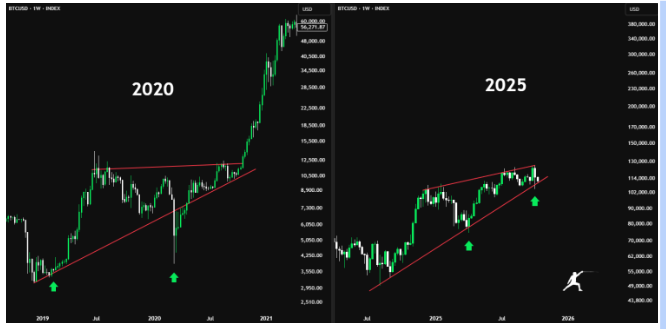Lead: The Key Facts, Currently
On 10–11 October 2025, the world’s crypto markets witness a violent, high-speed correction: billions of dollars’ worth of leveraged positions are liquidated and prices wildly fluctuate, then settle down to stability within days. The event takes away a ginormous amount of leverage, near-immediate liquidations are estimated at around $19 billion and has traders, exchanges, and institutional desks redoing risk models. (Reuters)
In a week, on-chain and price action are building a recovery pattern most traders simply call reaccumulation: steady inflows from large holders, steady ETF and spot-buying, and falling exchange balances as coins are moved to cold storage. That mix says the market’s accumulating liquidity and confidence rather than capitulating.

After a $19B crash, crypto rebounds as whales buy and ETFs pour in: reaccumulation begins. (Image Source: Holder.io)
What Happened: Short And Sharp
There is a chain reaction that results in the crash: a macro surprise or a geopolitical shock surprises risk assets, derivatives markets exaggerate action through focused leverage, and automated liquidations cascade across exchanges. Margin calls push short-term volatility into a short, vicious downside spike; then buyers with dry powder step in. In this episode, futures deleveraging was one of the main channels for the destruction, and its magnitude ranks it as one of the biggest 24-hour liquidation episodes in crypto history.
Why The Market Did Not Remain Down
Three structural forces rapidly push prices back up:
- Institutional Buffers And ETF Flows. Institutional purchasing through the spot and ETF channels continues to supply buying pressure. Systematically amassing funds and corporate treasuries see the dip as an entry point.
- Whale Congregation And Exchange Outflows. On-chain metrics show massive net outflows from exchanges and heavy whale purchasing classic signs that large holders move funds off exchanges and into cold wallets or custodian vaults. That reduces short-term sell liquidity and signifies confidence in the long term.
- Benefit From Cleaner And Flusher Market Internals. The collapse of speculative leverage reduces systemic risk. Once the excess leverage is flushed out, forward volatility can tighten and market microstructure improves making reaccumulation more likely.
The Read On On-Chain Metrics (What The Data Says Now)
On-chain providers identify a series of converging indicators:
- Exchange Balances Decrease. Net outflow sees coins leaving trading pools and going into custody, a build pattern consistently seen at the start of multi-month bull trends. (Investing.com)
- Realised-Value And MVRV Trends Are Comforting. Market watchers note that MVRV and similar ratios show the market continues to be in areas below euphoria and there’s room on the up-side if buying interest returns.
- Big Wallet Action Improves. Whale activity taking up dips and acquiring positions equates to long positions rather than short-term spec.
These readings do not make the upturn linearly certain, yet they are a reaccumulation tale: heavy hands build positions quietly as volatility normalizes.
Story: A Trader, A Custodian And A Fund Human Signals
Consider three market players in varying rooms of the same global market.
A retail trader sees the chart decline and panic, sells; their position is shut down on an exchange order book. An exchange collateral manager spends the ensuing hours soothing systems and activating circuit breakers. Simultaneously, elsewhere, an institutional custodian is told to take out large blocks from the exchange into cold storage, a measured, deliberated buy that doesn’t light up social streams but shows up with unbudging certainty on ledgers.Those three moves stain human quality in the market: panic, fight procedure, and calm professional currents reestablish equilibrium. The collapse exposes weakness; the reaggregation demonstrates how diverse players behave emotionally and functionally and why markets don’t always have to return to previous froth to heal.

Panic, control, and calm: the market rebalances. (Image Source: Dot Net Tutorials)
Institutional Players: Dipping Or Hedging Risk?
Larger players do two things on the surface that appear similar but are quite different: hedge exposures and buy the dip. For treasuries and long-term holders, the sell-off is an excellent cost basis opportunity. For trading desks, the same window necessitates rebalancing and increased hedging in derivative, option and OTC markets.
News over the past few days has seen institutions shift from passive to active approaches: obtaining yield via Bitcoin restaking, considering DeFi primitives for yield on large BTC positions, and augmenting in regulated products. Those flows offer a feedback loopincreased institutional demand stabilizes order books and brings retail back in with diminished fear.
Regulation And The Big Picture
The crash is utilized as a test case by global institutions and policymakers. The Financial Stability Board and G20 experts mention gaps in cross-border regulation and touch upon the need for harmonized structures that restrict contagion risk between markets. Expect heightened regulation of derivatives, custody and stablecoin transparency requirements. Policy reform may transform structural flows; more transparent rules could attract further institutional capital in the long term.
The G20’s Financial Stability Board has warned of ‘significant gaps’ in global crypto regulation. While risks are limited for now, the rapid surge of Bitcoin, Ethereum, and stablecoins has experts calling for stronger rules and global coordination.@eriknjoka tells you more pic.twitter.com/L08Cdz0pMb
— WION (@WIONews) October 18, 2025
Market Structure Impacts You Could Expect During Reaccumulation
- Smaller Retail-Only Pools Of Liquidity: Order books on the exchange may have reduced retail depth; bigger market moves are more out of OTC and institutional venues. (Investing.com)
- More Custody And Cold Storage Flows: Net custody outflows are a feature of accumulation and reduce on-exchange selling pressure. (Investing.com)
- Derivative Product Innovation: Exchanges and platforms sell new hedging and yield instruments, while desks attempt to manage returns on large positions.
How Investors And Individual Traders Should See It
- Don’t confuse violent volatility with a structural break. Flash crashes can wash out over-leverage and leave a healthier market behind. (insights.glassnode.com)
- Track on-chain flows, not price. Exchange balances, whale transfers and realized supply measures give leading indications that price won’t. (Investing.com)
- Position sizing and liquidity matter more than ever. Oversized positions are punished by sharp moves. Use stop management and consider how liquidity will behave under stress.
Early Opportunity Signals And Actual Risk
- Opportunity: Periods of reaccumulation are typically simultaneous with improved long-term profits, should there be institutional buying. Net ETF/spot inflows and declining exchange balances are the two most glaring bullish signs to monitor.
- Risk: Regulator shocks, other macro shocks, or concurrent collapse at a major exchange can cause panic once again. The market is coming back, not bulletproof. Risk management is still justified.
The Single Most Useful Fact: Follow Supply, Not Price
Price sets, headlines follow: The market story these days is in supply streams; exchange reserves, whale trades and ETF flows. The three lines of data set whether the recent correction signals persistent buying or another crazy side-step.Exchange balances show coins leaving trading pools: That’s not speculation; that’s intent. As hundreds of millions of dollars’ worth of Bitcoin are moved out of exchanges and into custody, sellers are no longer able to directly access those coins. That reduction in available supply on order books lowers the market’s capacity to sell into follow-on rallies, and it usually precedes more sustained advances. Most recent reports show Bitcoin exchange reserves plunge to multi-year lows, with some 45,000 BTC withdrawn in October a telling indication of accumulation.
ETF flows cloud the picture: Spot ETFs move large capital with speed. In flash-crash episodes, ETFs signal first heavy inflows with market-stabilizing consequences and then expeditious redemptions with higher volatility. Mid-October evidence shows both impulsive inflows and rapid outflows on different days, a seesaw that creates irregular price activity but fails to undo the prevailing trend of institutional demand. Track ETF net flows daily: long-term inflows are more powerful than one-day noise.
Liquidation figures give context, not destiny: Analyst estimates of the October occurrence range from wiping out more than $19 billion of leveraged positions. That purging cleans one source of vulnerability and tends to leave a cleaner market on which accumulation can stick. But it also raises the bar on short-term calm: any subsequent macro shock can cause the next waterfall. Liquidations need to be considered as a reset, not as a buy signal.
On-Chain Signals I Watch And How To Read Them
- Exchange Reserves (Exchange Supply): When the line is falling, there is accumulation. Short-term speculators are losing selling power in the short term. When reserves decline as price stabilizes or creeps up slightly, that is good. Latest numbers represent one of the lowest exchange supplies in six years, a classic indicator of accumulation.
- Netflows Into/Out Of ETFs: Monitor weekly totals. Huge, uninterrupted inflows into spot products have a floor effect on liquidity. Huge, unexpected outflows after a crash are feared; they are counted, but one week of redemption won’t eliminate months of inflows. Look at ETF charts first thing each morning for fund-level activity.
- Whale Wallet Activity: Whales moving coins to cold storage is a sign of intent to hold. Concentrated large purchases overlapping exchange outflow is stronger than fragmented transfers. On-chain analysts are reporting large wallets accumulating their positions following the crash.
- Derivatives Open Interest: When open interest plunges in a collapse, leverage is unwinding. That’s system health-positive, but can make liquidity thin. Observe OI to determine if desks come back into the market or stay on the sidelines. Current news reports a colossus deleveraging event; OI is still below pre-collapse highs. (Reuters)
- MVRV And Realised Cap Ratios: These are metrics for whether existing holders are in profit or loss. Low or negative MVRV indicates buyers still have unrealised losses to maneuver if buying demand returns. MVRV is thought to be below overheated areas, which suggests space to rebuild.

Low reserves, rising inflows, whale buys, and cooling leverage: quiet signs of crypto rebuilding. (Image Source: Token Metrics)
Practical Checklist: What Investors And Traders Can Do Now
This is a call to action. Use it as a guide to decisions, not as investment advice.
- Reconsider liquidity over size.
- Watch the exchange supply daily: If reserves keep declining as price stabilizes, accumulation is on the rise. If reserves rise drastically, look for selling pressure.
- Watch ETF net flow trends, not day-to-day noise: One week of redemptions following a crash is not a trend. Four weeks of redemptions could be.
- Practice staggered entries: If you require exposure, scale over days or weeks. The market remains dynamic.
- Defend with stop-losses that are aware of liquidity: Utilize stop sizes aligned with wider intraday volatilities; avoid stops in normal volatility ranges.
- Watch OTC desks and option skew: Rising option skew, options higher than calls, indicates rising fear. OTC desks will push around large blocks quietly; the price won’t reflect all supply or demand.
- Watch for custody and settlement whispers: Exchange or custodian computer glitches will spread fast. Check counterparties’ solvency and settlement horizons.
- Write down the thesis and exit plan: If you’re a buyer because of exchange balances falling, write down what new terms you’ll sell.
Three 6–12 Month Possibilities
I lay out likely trajectories so you can identify risk and opportunity.
- Slow Recovery And Reinforcement (Base Case). Institutions continue buying at a steady rate. Exchange reserves stay low. Volatility decreases as leverage is subdued. Price drags up over the course of months as macro stabilizes. This is a possible scenario that’s consistent with recent exchange outflows and steady ETF demand.
- Volatile Chop With Feast-Or-Famine Rallies (Alternate). ETF flows remain erratic. Macro headlines trigger sporadic redemptions. Price reverting to range trading with large intraday ranges. Accumulation ongoing, but large moves prompt ongoing rebalancing. This is characteristic of mixed ETF inflows/outflows and active derivatives hedging.
- New Capitulation (Tail Risk). Systemic collapse, a major custodian default, exchange failure, or final regulatory clampdown, brings back panic and drains liquidity. Reaccumulation is halted in its tracks as shoppers pull in their horns. This is low-probability near term, but the market today is watching regulation and counterparties intently.
Levels over Fear.
The last 2 Fridays have offered opportunities when most have been fearful.
BUT First, understanding the tape you’re in-
1- Clear Uptrend ❌
2- Clear Downtrend ❌
3- Chop ✅Chop = Sit in cash or buy lower levels of ranges.
You can’t buy breakouts in chop,… pic.twitter.com/GWi4CwXJ4d
— PBA (@801010athlete) October 20, 2025
Human Element: What This Phase Means To Different Participants
- Retail Investors: You’re more nervous; you can’t help it. Take reduced position sizes and don’t chase explosive comebacks.
- Professional Asset Managers: They buy on a lower cost basis to build over time; they appreciate custody, compliance, and liquidity.
- Exchanges And Custodians: They reinforce margin and settlement discipline to avoid system strain in future spikes. Regulators are paying attention.

Retail retreats, pros build, systems tighten: trust rebuilds. (Image Source: TVI MarketPro3)
Also Read: Quantum Computing’s Sooner-Than-Predicted Menace: Why Crypto Hurries to Future-Proof Blockchain
Closing Thought: The Market Rewrites Risk, Not Memory
Reaccumulation is not a fairy tale of uninterrupted rising prices. It is a structural remake: the market substitutes long-dated, custody-based positions for short-term, high-leverage behavior. That makes a difference because it reduces the chance that the next big move comes from the same dubious sources that caused the flash crash.
If exchange balances keep falling and institutional flows come back in, the market shows it’s consolidating with force. If ETF redemptions and derivative flows keep churning, volatility is the cover charge.
Observe supply, observe institutional flow, and treat the market as a living tapestry of human decision-making, some crazy, some rational. That’s the mindset that wins more often than some novelty-driven chart trick.
Frequently Asked Questions
- Q: What is “reaccumulation” in cryptocurrency?
A: Reaccumulation is a phase where institutions and long-term investors build weakness, shifting coins from exchange to custody, reducing sell pressure, and typically resulting in further gains. (Investing.com) - Q: Did exchanges collapse during the flash crash?
A: Systems were under heavy stress; there were wide spreads and suspended trading on some platforms. But the major exchanges maintained their core operationsthough the incident exposed operational and margin-management weaknesses. - Q: Is whale manipulation?
A: Large transfers and accumulation can influence short-term liquidity, but data available lean towards legitimate accumulation rather than rigged manipulation. On-chain flows suggest wallets converting to custody from exchange selling. - Q: How quickly can reaccumulation build into a bull run?
A: It is not a specific time frame. Reaccumulation is a healthier basis for a bull run, but one that needs persistent demand, particularly from institutions and tight macro conditions. It could be weeks or even months. - Q: Is October’s $19bn liquidation figure definitive?
A: Projections are in agreement on the $19bn as the amount of leveraged positions that were unwound; it is the size, but not result. The event cleans out leverage and can set the stage for better growth if demand remains. - Q: When exchange balances fall, is the price somehow magically higher?
A: No. Decreased exchange balances decrease local supply to sell, which is bullish pressure but the price still needs active buying. Low supply and no demand = stagnation. The market needs both: decreasing sell liquidity and ongoing buy demand. - Q: What early warning signs indicate resumed risk?
A: Abrupt ETF outflow surges, abrupt option skew spikes, abrupt exchange wallet inflow reversals, and additional derivatives open interest jumps all indicate risk appetite reverts to the downside. Follow these on a daily basis.

